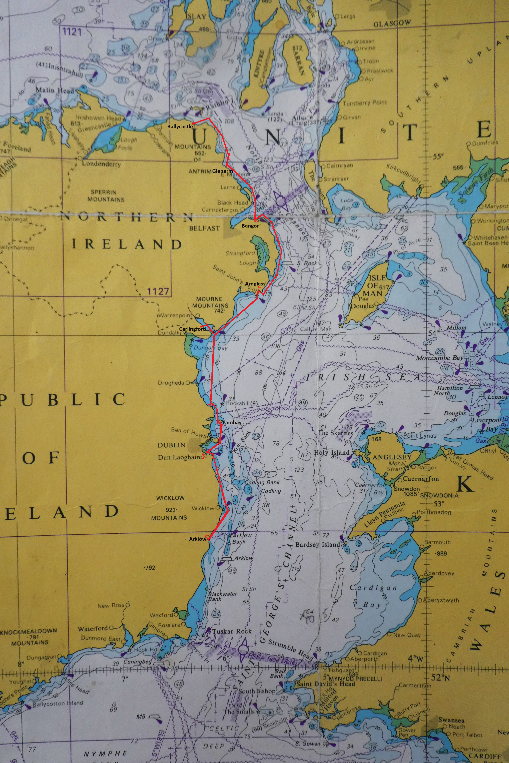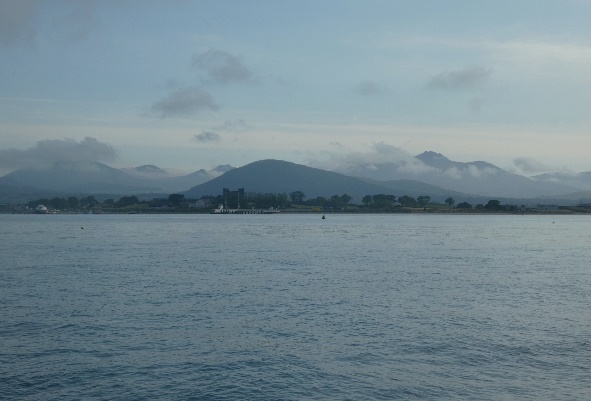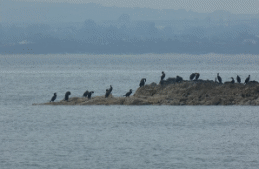July 2024 : Ireland
LaterEarlier |
Glenarm is a pleasant Antrim village which we’d visited before. Election night was spent there, watching news of exit polls before retiring to bed, then getting up again at 3am to watch the momentous Labour landslide materialise. Back to bed for a couple of hours before departure at 7.30 am for Bangor, 24 miles on, just into Belfast Lough. A decent though gusty breeze got us going at well over 5 knots under a double reefed genny through the water, plus 2 knots of very welcome south-going tide all down the Larne coast. The coast here is low-lying and unspectacular – we were certainly missing the ethereal misty folds of mountains in Scotland. Crossing Belfast Lough we could faintly pick out the gigantic iconic Sampson and Goliath cranes. Bangor marina is vast – 850 berths – and very impersonal. The town had little
interest other than an abundance of large forbidding-looking churches and
some rather lovely Walled Gardens.

However, the icing on the cake of our stay in Ardglass was our meeting with the parents of a neighbour of ours – who turned out to be a brilliant and welcoming ‘shore team’. On the worst day of very heavy weather they invited us for lunch at the golf club – the perfect thing to do on a day of torrential rain and wind, and generally offered support and helpful local knowledge. Strong south westerlies, which would have been welcome had we been continuing southwards down the coast, were a concern because we planned to go into Carlingford Lough which has a rocky shallow and narrow entrance with fast running tides. Strong winds coming straight out of the lough against a fast ingoing tide could cause dangerous conditions in the entrance. In fact we later met the crew of a boat which had experienced 4 metre waves on entering the lough. At a point just north of Carlingford Lough the tide ebbing and flowing between the Atlantic into the Irish Sea from the north meets the stream ebbing and flowing from the south – creating the highest tidal range and strongest tidal flows of the coast. In the event all went perfectly on a quiet sunny day. A trio of seals just outside Ardglass harbour entrance watched us depart as we turned towards the Mountains of Mourne, coming beautifully down to the sea. We entered the lough through the marked channel, carefully counting up the buoys to arrive into Carlingford marina. The border between Northern Ireland and the Republic of Ireland runs down the middle of Carlingford Lough so we had now entered the Republic of Ireland – however, no formalities were involved. In conversation with the marina staff in advance of our arrival Chris had raised this issue, to be told that they had no instructions regarding foreign yachts. Chris said he wouldn’t ask too many questions, meeting with the response that neither would they!
As we lost sight of the
Mountains of Mourn to the north, we were now looking at the bulk of the
Wicklow Mountains southwards beyond Dublin. We spent three days exploring
the sights of Dublin, berthed in the vast Dun Laoghaire marina – a 25 minute
train journey away.
Pressing on south we set off for Arklow – a strange passage in visibility of one mile giving us the illusion of being in a bubble, relieved only by our passage through Dalkey Sound – where we made fast progress through the narrow passage between the elegant looking little village of Dalkey with its castle, and the island dominated by one of the large numbers of Martello Towers in these parts. Sad not to have any sight of the Wicklow Mountains but compensated for by a 7.4 knot average for the 35 mile passage with the tide. Arklow, at the mouth of the River Avoca is well protected, with a long pontoon on the river bank for visiting yachts. Pleasant little place – a bridge of 19 arches and plenty of live music, but not of the sort we wanted. Instead we spent an afternoon in a pub watching the All Ireland Hurling Final on TV, in the company of three girls from County Clare – whose team won! Here we needed to make a final decision on where to cross the Irish Channel – from Arklow to Bardsey Island on the western tip of north Wales, or to Fishguard in South Wales, possibly via to Rosslare. The east coast of Ireland is generally quite shallow, with few places to anchor, so this phase of our journey was mainly marina hopping. It is not regarded as a cruising area - we hadn’t expected this to be a spectacular trip and it wasn’t. However, it was good to visit some new and interesting places, and although our quest for traditional pub music was a little disappointing, we enjoyed good craic in every pub we visited! Julia, Chris and Aremiti |
 The plan for this leg of our trip was to drift gently southwards down the
east coast of the island of Ireland on short passages, stopping wherever
seemed interesting, or to wait out heavy weather. We arrived in Northern
Ireland, from Scotland, in the small holiday town of Ballycastle. Well
situated for attractions as the Causeway Coast, Rathlin Island, and a long
beach, it looked as though its heyday had been in Victorian times judging by
the numerous imposing Victorian villas. Here, now in Ireland, we started
what became a month-long quest for pubs with live music. However, nothing
was on offer on weekdays in Ballycastle.
The plan for this leg of our trip was to drift gently southwards down the
east coast of the island of Ireland on short passages, stopping wherever
seemed interesting, or to wait out heavy weather. We arrived in Northern
Ireland, from Scotland, in the small holiday town of Ballycastle. Well
situated for attractions as the Causeway Coast, Rathlin Island, and a long
beach, it looked as though its heyday had been in Victorian times judging by
the numerous imposing Victorian villas. Here, now in Ireland, we started
what became a month-long quest for pubs with live music. However, nothing
was on offer on weekdays in Ballycastle.  The timing of ongoing passages was dictated by the strong tides through the
Irish Sea. Our departure from Ballycastle was timed for slack water around
Fair Head, but in fact we had favourable tide with us from start to finish
giving us an average speed of 8 knots for the 23 n mile passage to Glenarm!
Sadly, after a blustery wind coming out of Ballycastle, the wind dropped off
once round Fair Head.
The timing of ongoing passages was dictated by the strong tides through the
Irish Sea. Our departure from Ballycastle was timed for slack water around
Fair Head, but in fact we had favourable tide with us from start to finish
giving us an average speed of 8 knots for the 23 n mile passage to Glenarm!
Sadly, after a blustery wind coming out of Ballycastle, the wind dropped off
once round Fair Head.  The timing of our departure for Ardglass
was dictated by Donaghadee Sound, through which the tide rips at great pace.
With perfect timing we whizzed through with 3 knots of tide. The rest of the
passage was far less spectacular, but we retained good tide as we progressed
southwards down the Ards Peninsular, which separates Strangford Lough from
the sea. The Mountains of Mourn came into view south of us, with the Isle of
Man in sight to the south east as we approached Ardglass.
The timing of our departure for Ardglass
was dictated by Donaghadee Sound, through which the tide rips at great pace.
With perfect timing we whizzed through with 3 knots of tide. The rest of the
passage was far less spectacular, but we retained good tide as we progressed
southwards down the Ards Peninsular, which separates Strangford Lough from
the sea. The Mountains of Mourn came into view south of us, with the Isle of
Man in sight to the south east as we approached Ardglass.  We had been to Ardglass 3 years ago and it charmed us again as it did then –
which was lucky as we stayed there for rather longer than planned, due to
combination of heavy weather and Chris being unwell. Ardglass harbour and
marina are extremely well protected. The tidal range is clearly revealed by
the alarming appearance of huge expanses of seaweed covered rock, leaving
the marina in not much more than a puddle, as the tide drops. The village is
full of interest - boasting a small but serious looking fishing harbour –
this was Ulster’s busiest port in the 15th century, no less than 5 medieval
towers, an elegant little Georgian square, a prestigious golf club with a
spectacular coastal setting and club house dating from 1405, when it was
built as fortified warehouses, and the Victorian hexagonal stone bathing hut
on the stony shore.
We had been to Ardglass 3 years ago and it charmed us again as it did then –
which was lucky as we stayed there for rather longer than planned, due to
combination of heavy weather and Chris being unwell. Ardglass harbour and
marina are extremely well protected. The tidal range is clearly revealed by
the alarming appearance of huge expanses of seaweed covered rock, leaving
the marina in not much more than a puddle, as the tide drops. The village is
full of interest - boasting a small but serious looking fishing harbour –
this was Ulster’s busiest port in the 15th century, no less than 5 medieval
towers, an elegant little Georgian square, a prestigious golf club with a
spectacular coastal setting and club house dating from 1405, when it was
built as fortified warehouses, and the Victorian hexagonal stone bathing hut
on the stony shore.  As it was a Friday night we set off straight to town on our continuing quest for
traditional live music. The little town was buzzing with activity this
weekend, not least due to an influx of people from over the border come to
escape the 12th July events there. It is also apparently a favourite
location for hen and stag parties from all over Ireland. Here we met with
some success. However, it turns out that ‘traditional music’ means 60s and
70s hits! Enjoyable but not quite what we were seeking - but the craic was
good and we had a very convivial evening.
As it was a Friday night we set off straight to town on our continuing quest for
traditional live music. The little town was buzzing with activity this
weekend, not least due to an influx of people from over the border come to
escape the 12th July events there. It is also apparently a favourite
location for hen and stag parties from all over Ireland. Here we met with
some success. However, it turns out that ‘traditional music’ means 60s and
70s hits! Enjoyable but not quite what we were seeking - but the craic was
good and we had a very convivial evening.  Next day we explored the town - picturesque with a number of medieval ruins –
the largest being the 12th century King John’s castle dominating the
harbour. Noting that the home of Joe Biden’s family (who emigrated in 1850)
was in the vicinity, we enquired further at the tourist office. It was not
in town and too far to walk – but, almost even better, it just happened that
the guy who drove Joe Biden around on his visit here while Vice-President,
was in the office! He proudly recounted the visit – involving a convoy of 22
SUVs and 6 months planning! Sadly the Leprechauns’ cavern was not open when
we went to investigate!
Next day we explored the town - picturesque with a number of medieval ruins –
the largest being the 12th century King John’s castle dominating the
harbour. Noting that the home of Joe Biden’s family (who emigrated in 1850)
was in the vicinity, we enquired further at the tourist office. It was not
in town and too far to walk – but, almost even better, it just happened that
the guy who drove Joe Biden around on his visit here while Vice-President,
was in the office! He proudly recounted the visit – involving a convoy of 22
SUVs and 6 months planning! Sadly the Leprechauns’ cavern was not open when
we went to investigate! 
 We set off the following day just after 0700 and hour after the start of ebb -
Carlingford Lough looking particularly pretty with the sun beginning to lift
the clouds over the surrounding hills. However, in virtually no wind, we had
to motor across the expanse of Dundalk Bay, stopping for lunch off Skerries,
which didn’t look particularly inviting, and overnighting off Lambay Island,
which did, in a very pretty anchorage skirted by rocks complete with
cormorants and a pastoral landscape ashore.
We set off the following day just after 0700 and hour after the start of ebb -
Carlingford Lough looking particularly pretty with the sun beginning to lift
the clouds over the surrounding hills. However, in virtually no wind, we had
to motor across the expanse of Dundalk Bay, stopping for lunch off Skerries,
which didn’t look particularly inviting, and overnighting off Lambay Island,
which did, in a very pretty anchorage skirted by rocks complete with
cormorants and a pastoral landscape ashore.
 Highlights were Trinity College, the Book of Kells,
O’Connell bridge across the Liffey - as wide as it is long, the GPO - site
of much revolutionary activity, the wonderful statue of Oscar Wilde in
Highlights were Trinity College, the Book of Kells,
O’Connell bridge across the Liffey - as wide as it is long, the GPO - site
of much revolutionary activity, the wonderful statue of Oscar Wilde in
 Merrion Square and a visit to the theatre to see Brian Friel’s ‘Dancing at
Lunghasa’ – the perfect play for our first visit to Ireland. And in Dublin
we finally succeeded in our quest fores a pub with traditional Irish music in
O’Donahue’s Bar! Our weirdest discovery about Ireland is that they don’t
have wine boxes – or even understand the concept of them!
Merrion Square and a visit to the theatre to see Brian Friel’s ‘Dancing at
Lunghasa’ – the perfect play for our first visit to Ireland. And in Dublin
we finally succeeded in our quest fores a pub with traditional Irish music in
O’Donahue’s Bar! Our weirdest discovery about Ireland is that they don’t
have wine boxes – or even understand the concept of them!